If you are looking to improve your health then start looking at your gut and the foods you put in it.
Food that are good for gut flora can help in a variety of different areas, and the purpose of this article is to give you a guide of what you should be eating, and shouldn't be eating, to improve your gut health and live a better life.
A healthy balance of gut flora is said to help with your health in many areas:
- Improved digestion
- "Good" gut bacteria has been shown to improve cases of diarrhea and may ease constipation. Certain good gut bacteria have even helped IBS patients, due to some symptoms of IBS being linked to an imbalance in gut flora (source: Healthline).
- Reduced inflammation
- According to a 2017 review in Frontiers in Immunology in which many studies were looked into and reviewed, a healthy gut flora can modulate systemic immunity and protect against various inflammatory diseases. Other reviews confirm this vague conclusion.
- Healthier skin
- Bacteriotherapy by ingesting probiotics has potential to prevent and/or treat various skin conditions such as eczema, atopic dermatitis, acne, and allergic inflammation or skin hypersensitivity, UV-induced skin damage, wound protection, and as a cosmetic product (source: Health Effects of Probiotics on the Skin).
- Mental health
- There is a growing amount of research suggesting that gut bacteria can effect mental health and improve conditions such as anxiety and depression--and boost your mood overall. Experts call this connection between your gut health and brain the gut-brain axis, or GBA. The evidence is limited but mounting, with a 2016 study finding probiotics to help with depression and a 2017 review in Annals of General Psychiatry finding the treatment to help with anxiety and depression. A balanced gut might even make you smarter and clear up brain fog.
- A Stronger Heart
- A 2016 review of clinical studies and experiments found a growing amount of evidence supporting the claim that probiotics improve cholesterol, lower blood pressure, inflammation and blood sugar levels.
- And more...
Gut flora can also help boost metabolism and help keep weight under control.
In a nutshell, a healthy balance of bacteria in the gut seems to be able to benefit just about every part of our health... which makes sense considering that it is well known to improve digestion and proper digestion is important for overall health.
You Need Good Gut Bacteria and You Need to Keep It Healthy
The first step to a healthy gut flora is to stop eating unhealthy foods. Foods that are overly processed, contain a lot of chemicals, are deep fried, etc. should be avoided (We'll talk more about what type of food to avoid in a bit).
Then you need to both: 1) eat foods that contain "good" gut bacteria so that you can restore a healthy balance, and 2) eat foods that will help feed and keep that "good" gut bacteria healthy.
Restoring a healthy balance of gut bacteria will also help keep bad bacteria out, helping eliminate the potential for adverse health effects.
8 Natural Probiotic Foods
"Probiotics" is just a word for good gut bacteria. So when you see probiotic foods at the store, these are just foods that contain bacteria that is beneficial for our guts.
But here we aren't going to tell you to go out and buy a bunch of "probiotic" labeled foods. Instead, let's talk about some amazing natural sources of probiotics.
*"Probiotics" occur naturally in certain foods. There is no need to buy probiotic drinks, etc. that have been artificially stuffed with probiotics.
Quick Summary of Naturally Containing Probiotic Foods:
- Fermented Vegetables - Pickles, Sauerkraut, Kimchi, Tempeh. Miso
- Fermented Drinks - Kefir , Kombucha
- Yogurts
Fermented Vegetables
First on the list of some foods you can eat to increase your healthy gut flora are fermented vegetables (although not all scientifically considered vegetables) like pickles, sauerkraut, etc.
1. Pickles

Pickles are nothing more than cucumbers that have been pickled with salt and sometimes vinegar... and they taste great on sandwiches, burgers or even all by themselves.
However, if you are currently eating pickles there is a good chance you aren't getting probiotics from them. Pickles that are pickled using vinegar do not contain probiotics... and this is usually what you find at the supermarket.
Probiotic-containing pickles are pickled with a salty brine solution and fermented. They are often kept in the salty solution for days or even weeks, in which probiotic bacteria strains like Lactobacillus start to grow and ferment them.
There is a lack of studies showing how much good bacteria pickles actually provide, but it seems to be on the lower end of the spectrum. One pickle brand called Olive My Pickle measured their probiotic levels and found about 1.2 - 1.4 billion CFUs per serving.
If you look at probiotic supplements you will often find around 10-50 billion CFUs per serving. CFUs are "colony forming units" and this is how the amount of bacteria is measured. The amounts vary greatly between supplements, but no matter how you look at things pickles are on the low side compared to such.
2. Sauerkraut
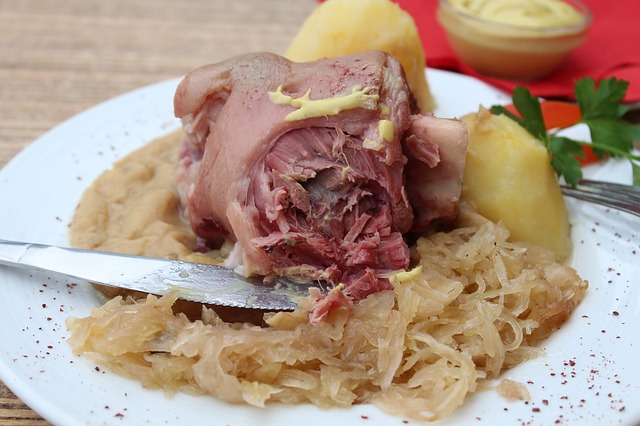
Sauerkraut is German for "sour cabbage" but actually originated farther to the east. As far back as 2,000 years ago Chinese laborers were eating this fermented food while building the Great Wall.
This dish consists of finely shredded cabbage with a salty/sour taste. It is often added to foods as a condiment, eaten by itself or added to soups and stews.
If you want sauerkraut with probiotics then you are going to want to avoid the canned stuff. This has been pasteurized and all the bacteria has been killed off during the process.
Fresh sauerkraut that is made without vinegar is what you want to look for.
According to Dr. Mercola and some sauerkraut he had analyzed, there are "literally ten trillion bacteria" in a 4-6 ounce serving, which would mean that about 2 ounces is providing more probiotics than a common 100 count probiotic supplement.
However, it is unclear how accurate these numbers are and we were unable to find the original source of such statement... but the bottom line is that this fermented cabbage does contain bacteria, and a lot of it.
A study conducted by Dr Chapman and assistants and published in Clean Eating Mag found a 1/2 cup serving to provide only 195.2 million CFUs, which is a massive difference--which shows how much bacteria counts can vary depending on the source.
3. Kimchi
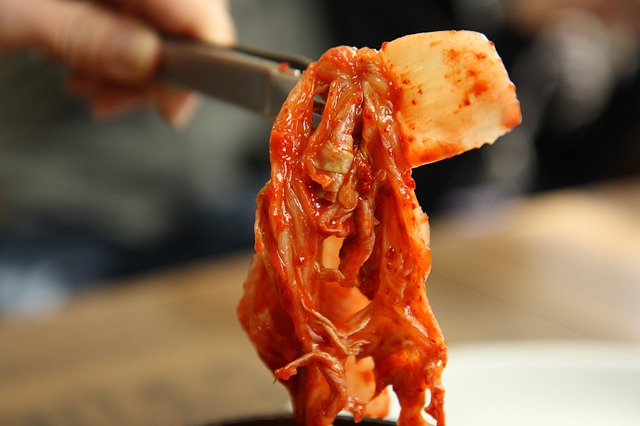
There are hundreds of different types of Kimchi but what most people in the western world are familiar with is that made by salting napa cabbage and adding spices, making it a sour and spicy vegetable choice.
This is a dish that originated in Korea as a way for the people in ancient times to enjoy fresh vegetables in cold winter times, because of how the fermentation process helps preserve foods.
It is commonly served with steamed rice but some people claim it also goes well in scrambled eggs, tacos, quesadillas, on pizza, and yeah... pretty much on anything.
The same study mentioned above from Clean Eating Mag found a 1/2 cup serving to have 2.6 billion CFUs, which is better than pickles but still not all that much.
4. Tempeh

Tempeh is a soy-based dish that is made from fermenting cooked soybeans... with the finished product being a dense cake which is somewhat similar to tofu and is said to taste like mushroom. The dish originated in the east and later made its way to the west.
Tempeh can be used just as tofu is used, which is usually as a meat substitute that can be added to sandwiches, salad rolls, tacos, or just about anything really.
Soybeans are known to impair the absorption of minerals, but the good news is that the fermentation of soybeans lowers the mineral absorption inhibiting phytic acid.
5. Miso

Miso is another fermented soy-based food. It can be traced back to the 4th century BC in China, its predecessor being hisio, and was later brought to Japan by Buddhist monks where it has since become a staple in Japanese foods.
This salty, savory fermented soybean paste is used as a main course in soup, added to salad dressing, mixed in marinades, as an alternative to soy sauce, and more. It is yet another very versatile food.
If you are going to be eating miso soup you have to be careful as to not heat it up too much, as this could kill the good bacteria. Some sources suggest only heating to 115ºF.
Probiotic counts for this dish aren't very clear but do appear to be low.
Fermented Drinks
Fermented drinks like kefir and kombucha are also good sources of probiotics.
6. Kefir

Kefir is a fermented milk drink that is made by adding grain-like colonies of yeast to milk. This is a drink that has been around for centuries and was discovered by accident, after shepherds found that milk carried in leather pouches would "go bad" and actually taste pretty good.
Kefir has a sweet taste but is also described as mild and tangy. It is usually drunk alone but some have found it delicious as a milk substitute in cereal, added to smoothies, and more.
An article published in Critical Reviews in Food Science and Nutrition states that kefir contains more than 50 probiotic bacteria species and yeast... which have been shown to have properties as antioxidatives, antiallergenics, anti-tumor agents, anti-inflammatories, to lower cholesterol, alleviate constipation and more.
There are many different kefir "grains" (not really grains, but bacteria cultures) from different areas of the world which contain different bacteria species and give kefir different benefits.
The study mentioned above that was performed by Dr Chapman found Kefir to have the highest amounts of probiotics at 27.7 billion CFUs per one cup serving (source: Clean Eating Mag). Which is the highest on this list according to this source.
7. Kombucha
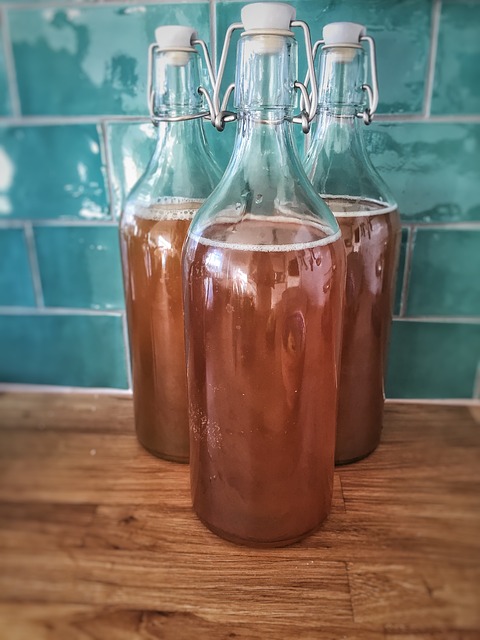
Kombucha is a basically sweet tea that has been fermented after bacteria and yeast has been added. This drink has an even older history, dating back to the Tsin Dynasty in China... 221 BC where it was referred to as "the tea of immortality". However, the name "kombucha" may have originated in Japan after the popular drink made it to other lands.
It's said to be able to help with diabetes, cardiac illnesses, immune health, and even claimed to prevent herpes.
However, there is some controversy surrounding kombucha's probiotic benefits due to the low amounts it supplies us with. According to Zhaoping Li, professor of medicine at University of California, it is 'from enough to make any real difference in health" (source: Vice).
8. Yogurts
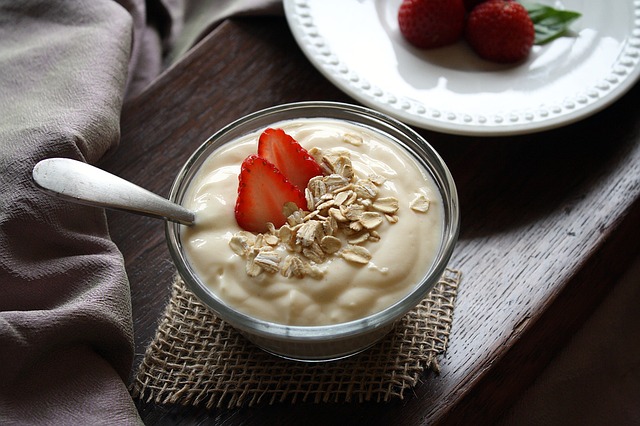
Yogurt can be an excellent source of probiotics and has been for thousands of years (there is evidence of cultured milk dating back as far as 10,000 years), provided that you buy good yogurt--because not all yogurt has good bacteria.
It is commonly made by fermenting milk with lactic acid bacteria (like Lactobacillus for example) and bifidobacteria, which are considered probiotics.
While many yogurts will contain probiotics naturally, some brands like Chobani and Yoplait take it a step farther and add in additional types such as L. acidophilus.
However, the amount of probiotics you are getting when eating yogurt is almost always unknown, since yogurt labels don't list the number of CFU's. You could be getting anywhere form 90 billion to 500 billion CFU's per serving according to a 2011 study by Consumer Reports.
If you are going to the store to purchase yogurt for the purpose of getting some good gut bacteria it is important that you look for a 'live and active cultures' seal or something of this nature. This ensures that there is actually live bacteria. Some yogurts are heat treated or processed in other ways that will kill any bacteria that existed... so you will want to keep an eye out for this.
Not All Fermented Foods Contain Probiotics
You probably have noticed that all of the foods listed above are fermented... fermented vegetables, fermented drinks, and yogurt, which is fermented milk.
However, not all fermented foods contain this good bacteria we are after.
Some fermented foods are heat-treated which kills the probiotic activity, and canned sauerkraut also leads to dead bacteria cultures.
And Not All Probiotic Foods are Equal
It's also important to note that not all probiotic-containing foods are equally effective. Not only are there many different types of probiotic bacteria contained in different foods, which affect our health differently, but the type of food that the bacteria is living in has a big impact on the survival of these little microorganisms.
Fermented dairy foods like yogurt and kefir are some of the best known options for delivering probiotics to the gut naturally. The body's stomach acid is what leads to the death of much bacteria before reaching the colon, and diary products like yogurt can help to neutralize this acidic environment for a short period of time to provide the bacteria with safe passage.
As for the many other types of probiotic containing foods that are coming to market, we don't know all that much about how effective they are at protecting the bacteria during transit.
*Note: Many probiotic supplements are pretty much completely useless because they do not address this problem, which means your stomach acid is likely killing most of the live cultures.
How to Introduce Probiotics Into Your Diet
While many people will have no problem taking up a diet with increased probiotic consumption, some might. Common side effects include temporary gas and bloating.
For this reason it is advisable to introduce probiotic-rich foods into your diet gradually so that your body can get used to them--and so you can get used to the increase in gas (joke).
8 Natural Prebiotic Foods
Prebiotics, in a nutshell, are food for probiotic bacteria. They are not living and are extremely easy to find.
Having a good supply and balance of bacteria in your gut is only one part of the equation. In order to keep the good bacteria healthy, you need to consume prebiotics for the bacteria to feed on.
Prebiotics are nothing more than dietary fiber and natural sugars, which you should already be getting in your diet.
Some good sources of prebiotics that you might want to add into your diet if they aren't there already include the following:
- Garlic - An herb that a good cook can't do without, garlic is more than just good for taste. According to Healthline, about 11% of it's fiber is inulin and a smaller amount of fructooligosaccharides, both of which are great for feeding gut bacteria.
- Onions - They are in the same family as garlic and are even more popular. Inulin makes up about 10% of the fiber they provide and they also have fructooligosaccharides.
- Bananas - They are tasty, healthy, extremely common, and can be good for gut bacteria. The greener the better. Greener bananas are higher in resistant starch, which give gut bacteria more to munch on. Bananas also contain pectin, which some strains of bacteria can make use of--although its prebiotic benefits might not be quite as great.
- Oatmeal - Whole oats are a great source of fiber. The beta-glucan fiber that oats give you has been found to increase good bacteria colonization in the gut (source: Interational Journal of Molecular Sciences)--along with improving cholesterol levels and heart health.
- Flaxseed - Flexseed is a fairly well-rounded health food, and has a good amount of prebiotics. One small tbsp will provide about 2.8g of fiber (source: USDA), about 20-40% of which is soluble and the remainder insoluble--excellent for feeding gut bacteria.
- Apples - An apple a day can provide you with a good amount of the soluble fiber pectin, which as mentioned bananas also have. FEMS Micriobioloty Ecology reported that pectin can help transform gut microbiota into a more anti-inflammatory profile--good news.
There is a good chance you are already eating some of the foods listed above, and this is good. However, if you want to provide your gut bacteria with all the food possible and give them the best chance of survival you may want to look into incorporating chicory root and Jerusalem artichokes...
*Note: A regular diet with good fiber as listed above is probably good enough.
7. Chicory Root
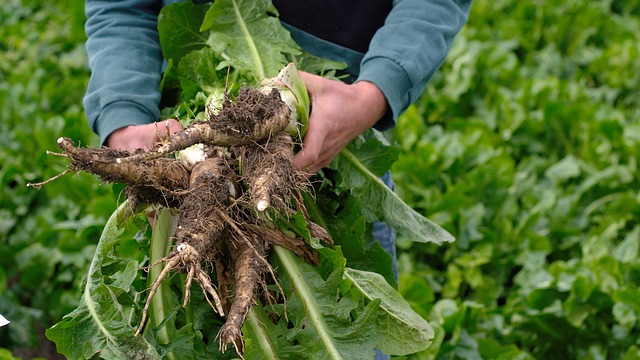
Chicory root is one of the best known prebiotics and this is why you often see it as an ingredient with probiotic supplements.
Nearly half of its fiber comes from inulin, which is a soluble fiber found in many plants, which was mentioned above.
Chicory roots can be boiled and eaten like any vegetable or, another good way to add these to your diet, they can be bought ground up and added to coffee (it tastes similar to coffee).
8. Jerusalem Artichoke
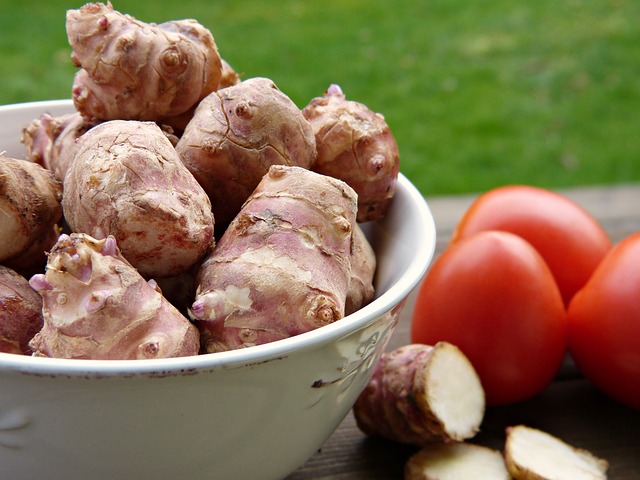
These are actually related to the sunflower and not the artichoke like you'd expect from the name.
They are excellent prebiotic sources of soluble fiber that your gut bacteria will absolutely love.
The bad news is that they have a reputation for giving people gas because of the high amounts of fiber, which is the result of your gut bacteria breaking down the food and releasing gas.
Both Chicory Root and Jerusalem Artichoke have been shown to increase numbers of good gut bacteria. In a 2016 study in Archives of Animal Nutrition Jerusalem Artichoke actually did a better job--but this study was performed with pigs and not humans.
How Much Prebiotics Do You Need?
If you eat a healthy and balanced diet with lots of fiber then you probably already are getting enough prebiotics that you won't have to worry about this.
However, in the US only about 5% of the population meets the Institute of Medicine's daily recommended amount of 25g for women and 38g for men (source: VOX).
So there is a good chance you want to eat more prebiotic rich foods, although there is no recommended amount.
Foods You Want to Avoid
1. Greasy Fast Food
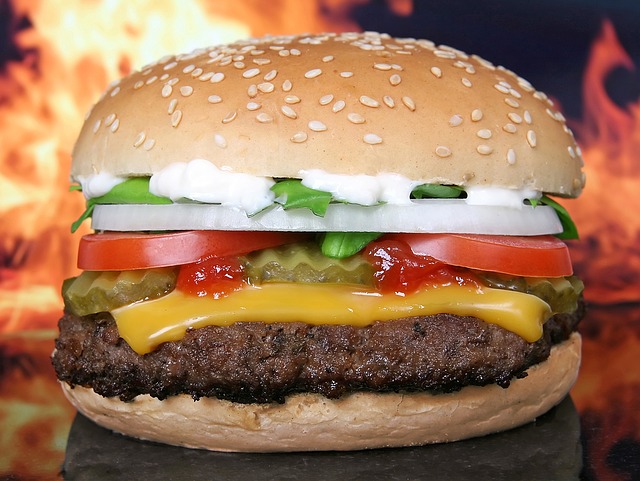
While not all fast food is unhealthy, a lot is. So you may want to stay away from those deep-fried fries and Big Macs.
The fats, added chemicals and preservatives that many fast foods contain aren't things that our guts like... although our taste-buds do.
A professor of genetic epidemiology at King's College London, Tim Spector, performed a study where his son (a college student) ate only McDonald's for 10 straight days. The results: his gut bacteria were "devastated" and he lost nearly 40% of his gut microbiota.
While it is far from being the most professionally conducted study, there is supporting evidence of overly greasy food loaded with preservatives causing harm to our gut flora.
2. Foods Loaded With Preservatives
Preservatives are added to food for preservation... to keep food from "going bad". They help limit bacterial contamination in the foods they are added to so it's no surprise that they also can damage our gut bacteria.
A 2017 study in PLOS One tested out the effects of two common food preservatives, sodium bisulfite and sodium sulfite, on four common probiotic bacteria species. The results showed that the preservatives inhibited and even deceased probiotic growth.
3. High Amounts of Alcohol

You don't need to avoid alcohol altogether, but consuming such in high amounts can have serious impacts on your health, and your gut microbiota.
According to Alcohol Research, large amounts of alcohol can directly stimulate bacterial overgrowth in the gut and indirectly cause overgrowth by leading to poor digestion and decreased intestinal functionality.
However, not all alcohol has negative effects. In a 2012 study in the American Journal of Clinical Nutrition ten healthy volunteers drank either red wine or gin for 20 days--the results were that red wine helped increase good gut bacteria diversity, which is likely due to the polyphenols it contains. The same can not be said for the gin.
Moderate beer consumption may also not be a bad choice. It's debatable and not well studied, but beer does contain fiber that could work as a prebiotic. That said, its high acidity is the downside.
4. Artificial & 0 Calorie Sweeteners
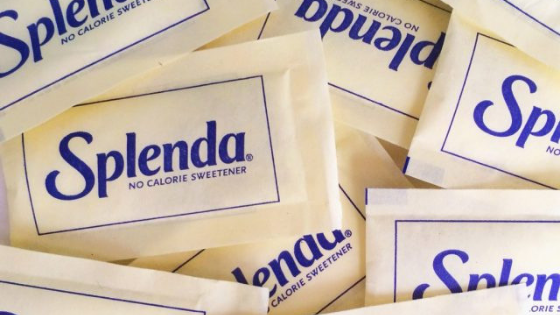
Artificial sweeteners are popular for 2 reasons: because they are cheap and because they often have low to 0 calories... but they come at a cost.
While artificial sweeteners aren't necessarily something you need to avoid altogether and they have different effects, it is probably a good idea to limit your consumption of such if you are trying to establish a healthy balanced gut flora.
Splenda has been found to inhibit bacteria growth in the gut and other 0 calorie sweeteners like saccharin and stevia can alter a health gut microbiota.
Soft drinks, candy, puddings, drink mixes, jams, etc... all commonly have artificial sweeteners.
The Takeaway
1. Probiotics Are Important for Health - Everything from the health of your skin, to inflammation and cognition can be effected by the bacteria in your gut.
2. You Can Get Probiotics Naturally Without Taking Supplements - Probiotics occur naturally in certain foods. Some of the best sources of natural probiotics include pickles, kimchi, sauerkraut, tempeh, miso, kefir, kombucha and yogurt. Dairy sources like yogurt and kefir are two top choices because they help bacteria get passed the deadly stomach acid.
3. Probiotics Need Prebiotics - In order to survive in our guts, probiotic bacteria need prebiotics to feed on, which consist of fiber and sugars. Onions, garlic, bananas, apples, oatmeal... there are lots of good prebiotic sources that are common.
4. Avoid Unhealthy Foods/Beverages - There are certain foods that should be avoided to keep a healthy and balanced gut microbiota. These include greasy fast foods, foods overloaded with preservatives, artificial sweeteners, too much alcohol of certain kinds, and so on.
A healthy gut is not something that you need to go out and spend a bunch of money to maintain. You just have to be aware of what you are putting in your body, avoiding foods that are unhealthy and increasing your intake of good natural probiotic sources.
Any type of food that is overly processed is probably best to avoid. And generally speaking, the more natural and organic the food is, the better.
The Last Thing to Remember
One of the last points to leave in your mind is that not all pickles provide the same amount of probiotics. Bacteria can be very fragile and growing it in food can be a challenge.
One organic sauerkraut brand might provide you with an adequate serving of probiotics while another organic sauerkraut brand might hardly provide any.
It can be difficult knowing what exactly you are buying at the store and what you are ingesting... so just try your best at the supermarket.
We love to hear from our readers. Leave any comments or questions below 🙂


Thank you, your writing is quite okay with preliminary idea for general people. But who are suppose to be expert with this topic they could do more.
ANY POSSIBILITY OF NAMING THOSE PICKELED PRODUCTS THAT DO PROVIDE A HEALTHY AMOUNT OF PROBIOTICS, SO AS TO AVOID THOSE NOT WORTHWHILE? THAT WOULD BE
EXTREMELY HELPFUL….THANK YOU.
making Sauerkraut yourself is extremely easy and i highly recommend it. lots to find on youtube.
Are there any bacteria that eat covid virus?
In 1996, my cousin in Arizona introduced me to the kombucha tea elixir she was making batches by herself, for her and her husband. She introduced Kombucha to her to her neighbors and to me at the Apache Wells RV Resort, Mesa, AZ where we resided. She taught me how to make my own from scratch, starting with a "Mother" mushroom I obtained from her. The mushroom's width and thickness were like pancakes. She stacked four in a glass jar containing Kombucha Tea. Kombucha's could grow baby mushrooms. Kombucha was easy to make. We brought bottles of Kombucha on our overland trip from Mesa, AZ to Seward, AK in 1996. After years washing my hair, I began to notice the top of my head of hair was thinning, causing a bald spot getting bigger. My cousin told me the medicinal benefits of kombucha. For me it was worth a try. My once bare hairless head of hair (in time) revealed by my touch, new growths of hair that covered the spot. My testimony; Kombucha works!! Kombucha became my daily morning elixir before breakfast from 1995 to 2008. After we moved from AZ to our different homes, I never made anymore Kombucha. I continued to run my fingertips on that area of my head of hair. Yes! Hair's still there in 2021!!